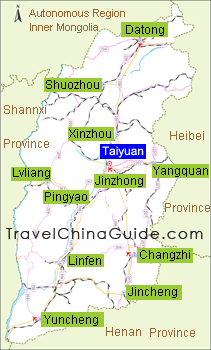Monday, August 30, 2010
Shanxi Province...Yangquan
Shanxi (help·info) (Chinese: 山西; pinyin: Shānxī; Wade–Giles: Shan-hsi; Postal map spelling: Shansi) is a province in the northern part of the People's Republic of China. Its one-character abbreviation is Jin (晋 pinyin jìn), after the state of Jin that existed here during the Spring and Autumn Period.
The name Shanxi literally means "mountain's west", which refers to the province's location west of the Taihang Mountains.[1] Shanxi borders Hebei to the east, Henan to the south, Shaanxi to the west, and Inner Mongolia to the north. The capital of the province is Taiyuan.
http://en.wikipedia.org/wiki/Shanxi
* Jinci in Taiyuan, famous for its temples and Song Dynasty paintings and architectures.
* Zuoquan County, famous for its China Communist Party battlefield sites.
* The Ancient City of Pingyao is a World Heritage Site near Taiyuan. Once a great financial center of China, it is noted for its preservation of many features of northern Han Chinese culture, architecture, and way of life during the Ming and Qing Dynasties.
* The Yungang Grottoes, a World Heritage Site in Datong, consist of 252 caves noted for their collection of 5th and 6th century Buddhist grotto sculptures and reliefs.
* Mount Wutai (Wutai Shan) is the highest point in the province. It is known as the residence of the bodhisattva Manjusri, and as a result is also a major Buddhist pilgrimage destination, with many temples and natural sights. Points of interest include Tang Dynasty (618–907) era timber halls located at Nanchan Temple and Foguang Temple, as well as a giant white stupa at Tayuan Temple built during the Ming Dynasty (1368–1644).
* Mount Hengshan (Heng Shan), in Hunyuan County, is one of the "Five Great Peaks" of China, and is also a major Taoist site. Not far from Heng Shan, the Hanging Temple is located on the side of a cliff and has survived for 1400 years despite earthquakes in the area.
* Pagoda of Fogong Temple, in Ying County, is a pagoda built in 1056 during the Liao Dynasty. It is octagonal with nine levels (five are visible from outside), and at 67 m (220 ft) in height, it is currently the tallest wooden pagoda in the world. It is also the oldest fully-wooden pagoda in China, although many no-longer-existing wooden pagodas have preceded it, and many existing stone and brick pagodas predate it by centuries.
* Hukou Waterfall is located in the Yellow River on the Shanxi-Shaanxi border. At 50 meters high it is the second highest waterfall in China.
* Dazhai is a village in Xiyang County. Situated in hilly, difficult terrain, it was a holy site during the Cultural Revolution, when it was set out to the entire nation as exemplary of the hardiness of the proletariat, especially peasants.
* The Cloud Ridge Caves are shallow caves near Datong. There are over 50,000 carved images and statues of Buddhas and Boddhisatvas within these grottoes, ranging from 4 centimeters to 7 meters tall.
Subscribe to:
Post Comments (Atom)

No comments:
Post a Comment